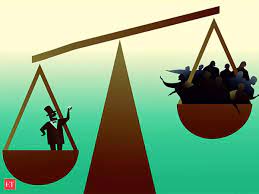CURRENT AFFAIRS
Get the most updated and recent current affair content on Padhaikaro.com
World Inequality Report
- Vaid's ICS, Lucknow
- 09, Dec 2021

Why in News?
The 2022 World Inequality Report (WIR) has been released.
What you need to know about the WIR?
- Released by the World Inequality Lab, a research center at the Paris School of Economics.
- The WIR studies different kinds of financial data to find out how a country’s (and the world’s) income and wealth are distributed.
Significance of the report– why do we need a study on inequalities?
- This is vital information because in most democracies, the wealthy can, and do, transform their economic power into political power, and therefore, the higher the inequality, the greater the likelihood that an affluent minority could end up determining the fate of the majority.
- Availability of accurate data about levels of inequality can help generate public opinion in favour of policy measures that can mitigate them.
Key findings of the 2022 report:
- The gap between the rich and the poor in terms of share of national income is quite large, and growing rapidly as a result of government policies that favour the affluent elite. The richest 10% of the global population takes home 52% of the global income, whereas the poorest 50% got only 8.5% of it.
- Global wealth inequities are worse than income inequalities. While the poorest 50% own just 2% of the global wealth, the richest 10% own 76% of all the wealth.
- Inequality between countries was narrowing while inequality within countries was increasing. While the gap between the average incomes of the richest 10% of countries and the average incomes of the poorest 50% of countries has dropped from 50x to less than 40x, the gap between the average incomes of the top 10% and the bottom 50% of individuals within countries has almost doubled, from 8.5x to 15x.
- Countries are growing richer, governments are becoming poorer: The share of privately owned wealth in national wealth was rising, while that of public wealth (buildings, universities, roads, hospitals etc) was shrinking.
Income inequality in India:
- India is one of the world’s most unequal countries, with the top 1% getting 21.7% of the national income.
- Top 10% of Indians capture 57% of the national income, while the share of the bottom 50% is only 13%.
- While the average national income of the bottom 50% stood at ₹53,610, the top 10% earned more than 20 times more, ₹11,66,520.
FACTS FOR PRELIMS:
Poshan Gyan:
- It is a national digital repository on health and nutrition.
- Launched by NITI Aayog, in partnership with Bill and Melinda Gates Foundation and Centre for Social and Behaviour Change, Ashoka University.
- The Poshan Gyan repository is conceptualized as a resource, enabling search of communication materials on 14 thematic areas of health and nutrition across diverse languages, media types, target audiences and sources.